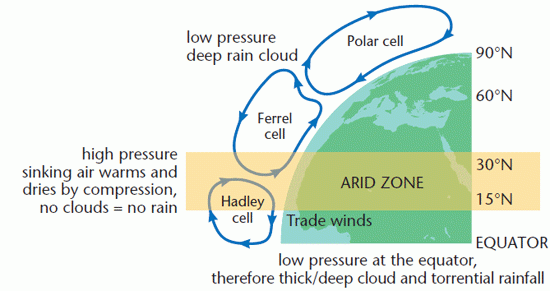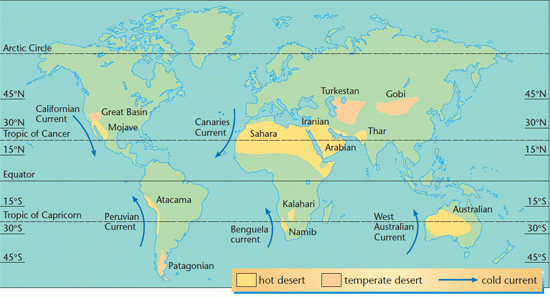The causes and distribution of deserts
After studying this section you should be able to understand:
- the causes of aridity
- the distribution of arid and semi-arid areas around the world
Aridity
Aridity is a lack of water and generally it can be classified by mean annual rainfall. Temperature also has an effect as it can determine evapotranspiration. Surprisingly many areas with similar rainfall regimes to Great Britain, may be classified as arid due to other factors at work.
The ‘rainfall definition’ of aridity
- 250 – 500 Semi-Arid Sparse vegetation such as grassland, few trees grow
- 25 – 250 Arid Plants only appear along river courses
- < 25 mm/yr Extremely Arid Plant growth only after rainfall
These classifications cover one-third of the world
The causes of aridity
Pressure
Deserts are found in 60+ countries of the world between 10° and 30° N and S. About one-third of the land surface of the world is classified as arid, semi-arid and/or dry.
Sand covers 20% of the Earth’s surface. Over 50% of this area is deflated desert pavements.

Cold ocean currents
Cold air present above such currents ensures that there is little moisture available to cool and form clouds. The coasts of Western, North and South America and Africa display such conditions. Both continents have west coast deserts just a little inland.
Rainshadow and continentality
Air descending from mountainous areas warms and dries by compression, little rainfall forms and aridity is the result. Central areas of continents are dry because air moving over landmasses does not absorb large amounts of water vapour. During the last ice age, conversion of water to ice resulted in larger continental areas. This extreme continentality is thought to have facilitated the spread of deserts during the ice age.
World wide distribution of deserts
The majority of the world’s most arid areas lie between 15° and 30° North or South of the equator (see map).

